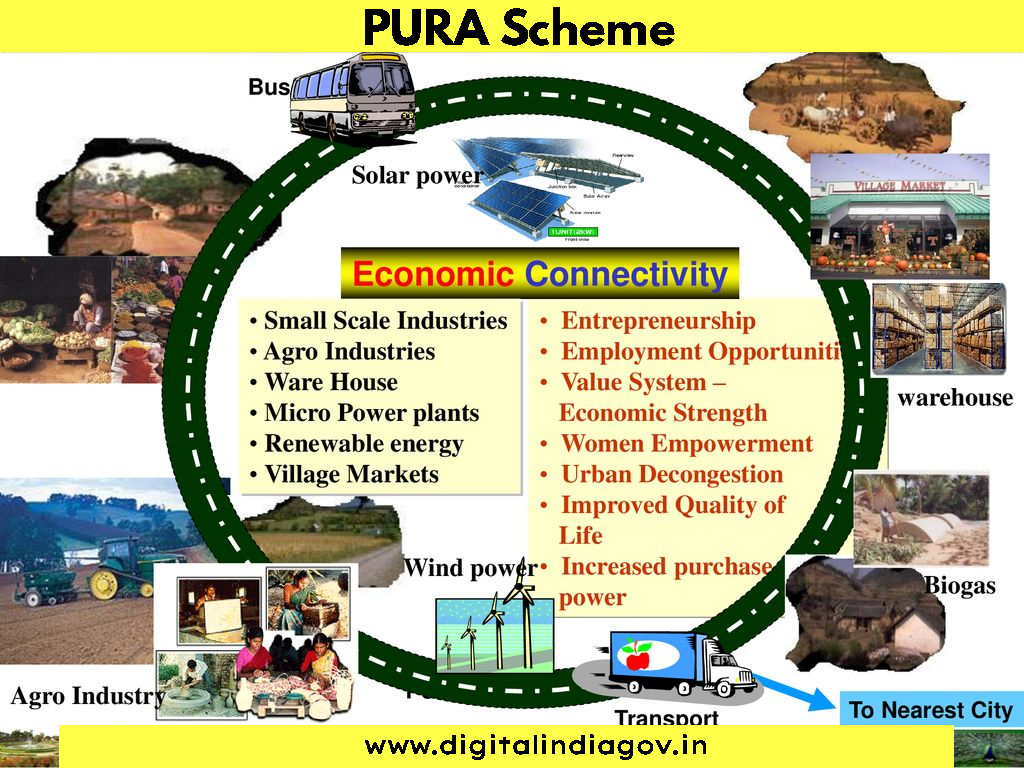PURA Scheme:- The PURA (Provision of Urban Amenities in Rural Areas) model was first introduced on Republic Day in 2003 by former president Dr. A.P.J. Abdul Kalam. For three years (2004–05 to 2006–07), the Ministry of Rural Development (MoRD) piloted the PURA plan in seven clusters. With assistance from the Department of Economic Affairs and the Asian Development Bank, the MoRD revived the PURA program as a Central Government program during the eleventh five-year plan. Using a Public-Private Partnership (PPP) model, it executed the PURA initiative in collaboration with private sector partners and local executive bodies such as gram panchayats.
Contents
Overview
Dr. Kalam introduced the PURA program proposal at the 90th Indian National Science Congress, which took place in Chandigarh in January 2004. The abbreviated form of offering services to every rural area is the Pura scheme. Move people from cities to rural areas in order to address the issues facing the rural communities. It gives rural areas access to clean drinking water and proper roads, meeting everyone’s basic needs—even in isolated settlements.

Also Read:- Jal Jeevan Hariyali Yojana 2, Digitize India, Digitize India Platform, Work From Home Jobs, Celebrity Phone Number, Digital India Data Entry Jobs, Mobile Number Tracker with Google Map
Background
Giving rural areas access to all provisions, the Indian government’s Ministry of Rural Areas has relaunched the plan. Public-private initiatives including all local authorities, including gram panchayats, and private sector partners oversee the PURA plan. These programs primarily target a specific area and offer advantages including the development of rural infrastructure and economic regeneration initiatives. The government’s initial attempt to provide infrastructure and basic services to all rural areas is the PURA project, which targets isolated rural communities. The goal of all of these initiatives is to achieve twofold benefits, such as effective agricultural infrastructure implementation and efficient asset management and service delivery to rural communities.
The objective of the PURA Scheme
The main goal of the program is to close the gap between rural and urban areas by offering urban facilities and chances for life to those living in rural areas. In order to improve the quality of life in rural areas, it envisions a PPP model that will accelerate and integrate the development of the rural areas surrounding a potential growth center in a gram panchayat.
Features of the PURA Scheme
- The state governments help gram panchayats and private sector partners in a public-private partnership (PPP) that achieves the scheme’s goals.
- The primary funding for PURA will come from the central sector scheme, which will also get additional support from the convergence of different central government schemes.
- Aside from operational know-how, the private sector contributes its fair share of capital.
- While the private sector oversees and implements the strategy based on its economic viability, it is meant to be closely aligned with the overall goal of rural development.
Amenities Provided Under PURA Scheme
The facilities offered by the MoRD schemes are as follows:
- Water and sewerage.
- Construction and maintenance of village streets
- Drainage
- Solid waste management
- Skill development
- Development of economic activities
Following are the amenities provided under the Non-MoRD schemes:
- Village street lighting.
- Telecom.
- Electricity.
Following are the amenities provided under the add-on projects (Revenue earning and people-centric projects):
- Village-linked tourism.
- Integrated rural hub and rural market.
- Agri – common services center, warehousing, etc.
- Any other rural-economy-based project.

Also Read:- Har Hith Store Yojana
PURA Scheme Implementation
A fair and competitive technical bidding process with strict qualification standards and evaluation criteria is used to choose private developers. Based on their acquaintance with the area or their past work at the grassroots level, the private developers are free to choose and identify the gram panchayat for carrying out the PURA projects. The choice of the gram panchayat would represent the agreement of all parties involved since it is necessary to have the approval of the relevant panchayats and no opposition from the state governments.
For each of the several PURA sub-projects, the private developers will carry out an action plan over a maximum three-year construction period and a ten-year operations and maintenance (O&M) period beginning on the date of commercial operation or construction completion. Under the overall guidance of the project screening and monitoring committee, a dedicated project management team within the PURA division of the MoRD will organize and oversee all activities relevant to the scheme’s implementation. These four sources of funding are available to projects funded under the PURA scheme: capital grants under PURA, non-MoRD programs, private financing, and MoRD schemes.
Business model
The PURA scheme is a business proposal that spans five years and involves both public and private sectors. Its anticipated budget is Rs. 100 crore, and it involves partnerships between the public and private sectors. However, the Ministry of Rural Development initially intends to establish two PURA groups using seed money in each of the nation’s 600 districts. It might draw interest from the public and private sectors to provide value-added services in the three economic sectors and function as long-term business ideas. The PURA system has been implemented in several states, including Chhattisgarh, Kerala, and Karnataka, as a result of government initiatives. Additionally, certain private firms have developed the scheme in Tamil Nadu, Madhya Pradesh, Maharashtra, and Andhra Pradesh.

Also Read:- Antyodaya Anna Yojana
FAQ’s
Q. What is the purpose of the PURA program?
Ans- In order to close the gap between urban and rural India, the scheme’s main goals are to provide livelihood possibilities and urban conveniences to rural areas.
Q. What standards were applied while selecting the Private Developers to carry out the PURA scheme?
Ans- A thorough qualification and evaluation procedure together with an open, competitive technical bidding process were used to reach the final selection. Since they are pilot initiatives, no financial bidding has taken place. Based on their technical proficiency, the bidders in the pilot projects received scores determined by a pre-approved evaluation process.
Q. What process was used to select the Gramme Panchayat(s) for the PURA?
Ans- During the pilot phase of PURA projects, the private developer is free to select the Gramme Panchayats, provided that they have previous experience working at the grassroots level or are familiar with the area. But since the state governments cannot protest and the concerned Panchayats must agree, the choice will represent the agreement of all parties involved.
Suggested Link:- Our Jharkhand
@PAY
